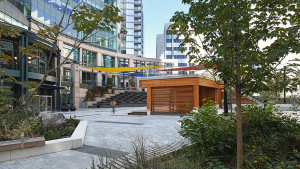Stakeholders in Ontario’s wood construction sector are praising the provincial government’s proposed action plan for the industry as comprehensive, far-reaching and a strong next step towards creating incentives for expansion.
The province’s draft was launched for public input on July 30 as part of an event at the mass timber manufacturing plant in St. Thomas, Ont. The plan is said to target growth in prefabricated and modular wooden building materials and more broadly the advancement of the diverse players in the field.
During the event Ontario Associate Minister of Forestry Nolan Quinn announced the government was contributing $3.46 million towards Element5’s $23-million expansion, a project that will triple its production capacity.
‘Great starting point’
“We think it’s a really great starting point,” commented Chris Latour, vice-president of engineering and operations at Element5, about the draft plan. “Everything will evolve over time, but we think the provincial government’s done a great job of recognizing an opportunity that’s out there and really putting a great program together.”
The government believes the demand for mass timber construction materials will increase between 10 to 25 per cent each year during the next decade. The forest sector generated $22.8 billion in revenue from the sale of manufactured goods and services in 2022.
Advanced wood construction refers to developing and assembling building materials off-site before installation and includes prefabricated framing and trusses besides mass timber.
“This is a great step forward,” said Steven Street, executive director of .
“We do have a lot of housing supply opportunities in the province, and the fact that we can incentivize our own industries within the province to supply that, rather than going out of our jurisdictions and bringing products in, we need to capitalize on that opportunity here in our province.
“So I’m very excited by it.”
The deadline for comments on the action plan is Sept. 30. The document, posted on the province’s Environmental Registry, is said to provide a framework to “encourage the use of innovative wood building products and systems beyond the traditional site-built construction used in most single-family homes.”
The action plan has four objectives to be pursued over five years: support promotion, education and training initiatives; spur research and the advancement of codes, standards and regulations; stimulate innovation and advanced manufacturing; and demonstrate and display advanced wood construction.
“We’re going to have to train workers,” said Street. “We’re going to have to bring on factory processes. It’s linked with natural resources, with forestry, with wood supply, economic development with factory built, and how you intend to incentivize industry to get behind this.”
WoodWorks and Element5 representatives were consulted by the provincial government over the last year as the action plan was drafted as part of the government’s Forest Sector Investment and Innovation Program. Several ministries have been involved in creating policy including housing, natural resources and the industry ministry, they noted.
Europe has head start
“I think the beautiful thing about this particular approach that the government’s done is it’s linked several ministries together,” said Street. “You’ve got job creation, you’ve got upskilling.”
Street said the province’s impending plan to introduce mass timber construction in highrises up to 18 storeys in the Building Code was another positive step in advancing the sector.
The Element5 plant in St. Thomas, Ontario’s only mass timber manufacturing facility, opened in 2021. Latour noted while the Ontario mass timber sector has seen strong growth in the last few years, it is still far behind Europe, which has been producing mass timber for decades, and manufacturers on the west coast.
Not all manufacturers have prospered, said Latour, “and so we’re very conscious that we want to make sure to deliver what the sector is looking for at the time the sector is looking for it.”
The public education component of the action plan is important, Latour said, in that all stakeholders must come to understand project designs and engineering.
“The nuances to the design, and working with architects and engineers upfront, has allowed us to continue to grow that industry,” he said. “As it all gets rolling, more people get comfortable with it…and the amount of demand increases exponentially.
“We’ve been very fortunate, the schools, universities in Ontario, in the U.S., have really adopted mass timber and really led to a higher level of education.”
Follow the author on X/Twitter .









Recent Comments
comments for this post are closed